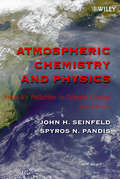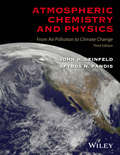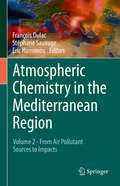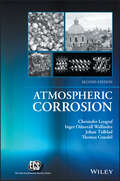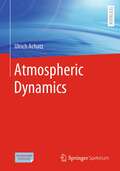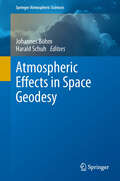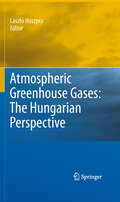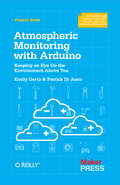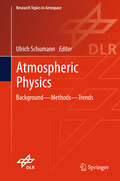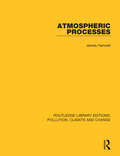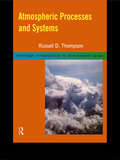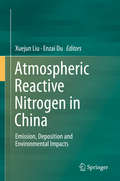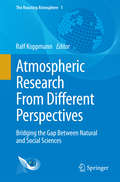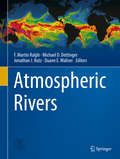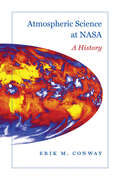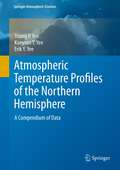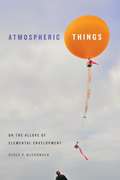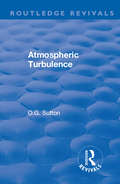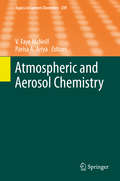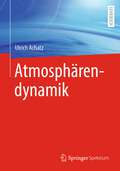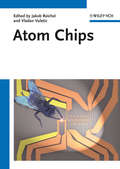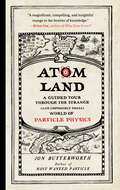- Table View
- List View
Atmospheric Chemistry and Physics
by John H. Seinfeld Spyros N. PandisThoroughly restructured and updated with new findings and new featuresThe Second Edition of this internationally acclaimed text presents the latest developments in atmospheric science. It continues to be the premier text for both a rigorous and a complete treatment of the chemistry of the atmosphere, covering such pivotal topics as:* Chemistry of the stratosphere and troposphere* Formation, growth, dynamics, and properties of aerosols* Meteorology of air pollution* Transport, diffusion, and removal of species in the atmosphere* Formation and chemistry of clouds* Interaction of atmospheric chemistry and climate* Radiative and climatic effects of gases and particles* Formulation of mathematical chemical/transport models of the atmosphereAll chapters develop results based on fundamental principles, enabling the reader to build a solid understanding of the science underlying atmospheric processes. Among the new material are three new chapters: Atmospheric Radiation and Photochemistry, General Circulation of the Atmosphere, and Global Cycles. In addition, the chapters Stratospheric Chemistry, Tropospheric Chemistry, and Organic Atmospheric Aerosols have been rewritten to reflect the latest findings.Readers familiar with the First Edition will discover a text with new structures and new features that greatly aid learning. Many examples are set off in the text to help readers work through the application of concepts. Advanced material has been moved to appendices. Finally, many new problems, coded by degree of difficulty, have been added. A solutions manual is available.Thoroughly updated and restructured, the Second Edition of Atmospheric Chemistry and Physics is an ideal textbook for upper-level undergraduate and graduate students, as well as a reference for researchers in environmental engineering, meteorology, chemistry, and the atmospheric sciences.Click here to Download the Solutions Manual for Academic Adopters: http://www.wiley.com/WileyCDA/Section/id-292291.html
Atmospheric Chemistry and Physics: From Air Pollution To Climate Change
by John H. Seinfeld Spyros N. PandisExpanded and updated with new findings and new features New chapter on Global Climate providing a self-contained treatment of climate forcing, feedbacks, and climate sensitivity New chapter on Atmospheric Organic Aerosols and new treatment of the statistical method of Positive Matrix Factorization Updated treatments of physical meteorology, atmospheric nucleation, aerosol-cloud relationships, chemistry of biogenic hydrocarbons Each topic developed from the fundamental science to the point of application to real-world problems New problems at an introductory level to aid in classroom teaching
Atmospheric Chemistry in the Mediterranean Region: Volume 1 - Background Information and Pollutant Distribution
by François Dulac Stéphane Sauvage Eric HamonouThis two-volume set provides an extensive review of the abundant past and recent literature on the atmospheric chemistry in the Mediterranean region. The books document the experience gained on the atmospheric composition over the Mediterranean basin and close areas after almost six decades of studies, starting from early studies of radioactive aerosol fallouts and intense desert dust events in the 1960s, aerosol samples collected during oceanographic cruises in the early 1980s and including discoveries from subsequent surface monitoring stations, intensive campaigns, satellite climatologies, laboratory studies, as well as chemistry-transport and climate models. Through ten thematic sections, the authors examine the sources and fates of atmospheric pollutants over the Mediterranean basin and what we know about their major impacts on air quality and health, on the radiative budget and climate, on marine chemistry and biogeochemistry. This overview not only considers the full cycle of both aerosol and reactive gases including emissions, transport, transformation, and sinks, but also addresses the main impacts of the regional atmospheric chemistry. The volumes are an initiative from the ending ChArMEx project that has federated many studies on those topics in the past decade, and update the scientific knowledge by integrating the ChArMEx and non-ChArMEx literature. The books are contributed by a large pool of well-known authors from the respective fields, mainly from France and Greece, but also from fourteen other countries. All chapters have been peer-reviewed by international scientific experts in the corresponding domains. Volume 1 provides background information on the Mediterranean atmosphere, and focuses on the synoptic and dynamic conditions affecting pollutant concentrations over the Mediterranean basin, aerosol concentrations and variability, and reactive gas concentrations and variability. The targeted audience is the academic community working on atmospheric chemistry and its impacts on climate, air quality and marine biogeochemistry, especially teams having a special interest in the Mediterranean region, which includes many countries and institutes worldwide.
Atmospheric Chemistry in the Mediterranean Region: Volume 2 - From Air Pollutant Sources to Impacts
by François Dulac Stéphane Sauvage Eric HamonouThis two-volume set provides an extensive review of the abundant past and recent literature on the atmospheric chemistry in the Mediterranean region. The books document the experience gained on the atmospheric composition over the Mediterranean basin and close areas after six decades of research, starting from early studies of radioactive aerosol fallouts and intense desert dust events in the 1960s, followed by studies of aerosols collected during oceanographic cruises in the early 1980s, and including subsequent knowledge from various surface monitoring stations, intensive campaigns, satellite climatologies, laboratory studies, as well as chemistry-transport and climate models. Through ten thematic sections, the authors examine the sources and fates of atmospheric pollutants over the Mediterranean basin and what we know about the main impacts of the regional atmospheric chemistry. This overview not only considers the full regional cycle of both aerosol and reactive gases including emissions, transport, transformations, and sinks, but also addresses their major impacts on air quality and health, on the radiative budget and climate, on marine chemistry and biogeochemistry . The volumes are an initiative from the ChArMEx project that has federated many studies on those topics in the 2010-2020decade, and update the scientific knowledge by integrating the ChArMEx and non-ChArMEx literature. The books are contributed by a large pool of well-known authors from the respective fields, mainly from France and Greece, but also from six other Mediterranean and eight non-Mediterranean countries. All Chapters have been peer-reviewed by international scientific experts in the corresponding domains. Volume 2 focuses on emissions and their sources, recent progress on chemical processes, aerosol properties, atmospheric deposition, and the impacts of air pollution on human health, regional climate and ecosystems. Recommendations for future research in these fields are finally proposed. The targeted audience is the academic community working on atmospheric chemistry and its impacts, especially teams having an l interest in the Mediterranean region, which includes many countries and institutes worldwide.
Atmospheric Corrosion
by Johan Tidblad Inger Odnevall Wallinder Thomas Graedel Christofer LeygrafPresents a comprehensive look at atmospheric corrosion, combining expertise in corrosion science and atmospheric chemistry Is an invaluable resource for corrosion scientists, corrosion engineers, and anyone interested in the theory and application of Atmospheric Corrosion Updates and expands topics covered to include, international exposure programs and the environmental effects of atmospheric corrosion Covers basic principles and theory of atmospheric corrosion chemistry as well as corrosion mechanisms in controlled and uncontrolled environments Details degradation of materials in architectural and structural applications, electronic devices, and cultural artifacts Includes appendices with data on specific materials, experimental techniques, atmospheric species
Atmospheric Dynamics
by Ulrich AchatzThis textbook is intended for both undergraduate and graduate courses in meteorology and atmospheric sciences, as well as for researchers working on theoretical and numerical aspects of weather and climate or on geophysical fluid dynamics. The treatment is concise, thorough, and self-contained. All necessary concepts are introduced, and the reader is given explicit guidance on all mathematical steps.The book begins with a derivation of the equations of motion. These are then used to discuss fundamental aspects of weather and climate. The mechanisms behind vortical motions, that are known from the daily weather map, are discussed. Shallow-water theory is introduced as a tool for an efficient analysis of key concepts, such as atmospheric waves and synoptic-scale vortices. Quasigeostrophic theory is described and then used to explain the occurrence and mechanisms of extratropical weather by means of baroclinic instability. The specific properties of the atmospheric boundary layer are discussed, with a focus on the interaction between turbulence and mean flows. This is followed by a detailed look at the global atmospheric circulation, highlighting its control by Rossby waves and gravity waves.At the same time, the reader is introduced to essential concepts that find applications in the field, such as balance by geostrophic and hydrostatic equilibrium, the role of entropy and potential temperature, potential vorticity, the Kelvin theorem, instability theory, the Reynolds equations, Eliassen-Palm and pseudo-momentum flux, multi-scale asymptotics, WKB theory, wave action, the transformed Eulerian mean, critical layers, and wave refraction.The text is supplemented by appendices on important mathematical concepts and further elaborations of the main text. Chapter summaries and reading recommendations help the reader not merely to keep focus on the essentials, but just as well to broaden the horizon.
Atmospheric Effects in Space Geodesy (Springer Atmospheric Sciences)
by Harald Schuh Johannes BöhmVarious effects of the atmosphere have to be considered in space geodesy and all of them are described and treated consistently in this textbook. Two chapters are concerned with ionospheric and tropospheric path delays of microwave and optical signals used by space geodetic techniques, such as the Global Navigation Satellite Systems (GNSS), Very Long Baseline Interferometry (VLBI), or Satellite Laser Ranging (SLR). It is explained how these effects are best reduced and modelled to improve the accuracy of space geodetic measurements. Other chapters are on the deformation of the Earth's crust due to atmospheric loading, on atmospheric excitation of Earth rotation, and on atmospheric effects on gravity field measurements from special satellite missions such as CHAMP, GRACE, and GOCE. All chapters have been written by staff members of the Department of Geodesy and Geoinformation at TU Wien who are experts in the particular fields.
Atmospheric Greenhouse Gases: The Hungarian Perspective
by László HaszpraHuman induced global climate change is the biggest challenge humankind faces today. Increasing amount of atmospheric greenhouse gases play a crucial role in the evolution of the climate. Without the understanding of the contributing processes, feedbacks and interactions we cannot predict the future changes and develop effective mitigation strategies. To decrease the uncertainty of the global studies detailed regional studies are needed surveying the regional characteristics of the atmospheric greenhouse gas budget and the influencing factors. Atmospheric Greenhouse Gases: The Hungarian Perspective covers a coherent subset of the Hungarian climate change oriented research that is directly related to greenhouse gases. Topics discussed in the book range from the monitoring of the concentrations and fluxes of atmospheric greenhouse gases, through the modeling of atmosphere-biosphere interaction and greenhouse gas exchange processes, to the review of the anthropogenic contribution of Hungary to the greenhouse gas budget of the atmosphere. The studies call the attention to the regional properties which may modulate the European scale or global picture on the variation of atmospheric greenhouse gases.
Atmospheric Monitoring with Arduino: Building Simple Devices to Collect Data About the Environment
by Emily Gertz Patrick Di JustoMakers around the globe are building low-cost devices to monitor the environment, and with this hands-on guide, so can you. Through succinct tutorials, illustrations, and clear step-by-step instructions, you’ll learn how to create gadgets for examining the quality of our atmosphere, using Arduino and several inexpensive sensors.Detect harmful gases, dust particles such as smoke and smog, and upper atmospheric haze—substances and conditions that are often invisible to your senses. You’ll also discover how to use the scientific method to help you learn even more from your atmospheric tests.Get up to speed on Arduino with a quick electronics primerBuild a tropospheric gas sensor to detect carbon monoxide, LPG, butane, methane, benzene, and many other gasesCreate an LED Photometer to measure how much of the sun’s blue, green, and red light waves are penetrating the atmosphereBuild an LED sensitivity detector—and discover which light wavelengths each LED in your Photometer is receptive toLearn how measuring light wavelengths lets you determine the amount of water vapor, ozone, and other substances in the atmosphereUpload your data to Cosm and share it with others via the Internet"The future will rely on citizen scientists collecting and analyzing their own data. The easy and fun gadgets in this book show everyone from Arduino beginners to experienced Makers how best to do that."--Chris Anderson, Editor in Chief of Wired magazine, author of Makers: The New Industrial Revolution (Crown Business)
Atmospheric Physics: Background – Methods – Trends (Research Topics in Aerospace)
by Ulrich SchumannOn the occasion of the 50th anniversary of the Institute of Atmospheric Physics of the German Aerospace Center (DLR), this book presents more than 50 chapters highlighting results of the institute's research.The book provides an up-to-date, in-depth survey across the entire field of atmospheric science, including atmospheric dynamics, radiation, cloud physics, chemistry, climate, numerical simulation, remote sensing, instruments and measurements, as well as atmospheric acoustics. The authors have provided a readily comprehensible and self-contained presentation of the complex field of atmospheric science. The topics are of direct relevance for aerospace science and technology. Future research challenges are identified.
Atmospheric Processes
by James HanwellOriginally published in 1980, this book is an original approach to the study of the atmosphere at A Level and introductory undergraduate courses. A true understanding of the way the atmosphere works is only attainable on a firm basis of science and the book concentrates on this aspect in a clear and straightforward manner without introducing advanced mathematics. The book discusses the atmosphere in terms of a machine fuelled by the Sun and it deals with the energy involved in global circulations before looking at local processes and finally global patterns. With a clear recognition of the vulnerability of climate to our wellbeing on a global scale, this book remains as relevant now as when it was first published.
Atmospheric Processes and Systems (Routledge Introductions to Environment: Environmental Science)
by Russell D. ThompsonAtmospheric Processes and Systems presents a concise introduction to the atmosphere and the fundamentals of weather. Examining different aspects of the mass, energy and circulation systems in the atmosphere, this text provides detailed accounts of specific phenomena, including* the composition and structure of the atmosphere* energy transfers* the cycle of atmospheric water in terms of evaporation, condensation and precipitation* pressure and winds at the primary or global scale* secondary air masses and fronts* thermal differences and weather disturbances.The text includes sixteen boxed case studies, annotated further reading lists and a glossary of key terms.
Atmospheric Reaction Chemistry (Springer Atmospheric Sciences)
by Hajime AkimotoThis book is aimed at graduate students and research scientists interested in gaining a deeper understanding of atmospheric chemistry, fundamental photochemistry, and gas phase and heterogeneous reaction kinetics. It also provides all necessary spectroscopic and kinetic data, which should be useful as reference sources for research scientists in atmospheric chemistry. As an application of reaction chemistry, it provides chapters on tropospheric and stratospheric reaction chemistry, covering tropospheric ozone and photochemical oxidant formation, stratospheric ozone depletion and sulfur chemistry related to acid deposition and the stratospheric aerosol layer. This book is intended not only for students of chemistry but also particularly for non-chemistry students who are studying meteorology, radiation physics, engineering, and ecology/biology and who wish to find a useful source on reaction chemistry.
Atmospheric Reactive Nitrogen in China: Emission, Deposition and Environmental Impacts
by Xuejun Liu Enzai DuAtmospheric reactive nitrogen (N) emissions, as an important component of global N cycle, have been significantly altered by anthropogenic activities, and consequently have had a global impact on air pollution and ecosystem services. Due to rapid agricultural, industrial, and urban development, China has been experiencing an increase in reactive N emissions and deposition since the late 1970s. Based on a literature review, this book summarizes recent research on: 1) atmospheric reactive N in China from a global perspective (Chapter 1); 2) atmospheric reactive N emissions, deposition and budget in China (Chapters 2-5); 3) the contribution of atmospheric reactive N to air pollution (e.g., haze, surface O3, and acid deposition) (Chapters 6-8); 4) the impacts of N deposition on sensitive ecosystems (e.g., forests, grasslands, deserts and lakes) (Chapters 9-12); and 5) the regulatory strategies for mitigation of atmospheric reactive N pollution from agricultural and non-agricultural sectors in China (Chapters 13-14). As such it offers graduate students, researchers, educators in agricultural, ecological and environmental sciences, and policy makers a glimpse of the environmental issues related to reactive N in China .
Atmospheric Research From Different Perspectives: Bridging the Gap Between Natural and Social Sciences (The Reacting Atmosphere #1)
by Ralf KoppmannThe book, the first in a series arising from the research network The Reacting Atmosphere, explains and outlines the aims of this ambitious cross-disciplinary effort. The central topic is air quality and climate change, and the methods of atmospheric physics and chemistry, applied mathematics and socio-economic science are used to advance the understanding of the role of the atmosphere in global change.
Atmospheric Rivers
by F. Martin Ralph Michael D. Dettinger Jonathan J. Rutz Duane E. WaliserThis book is the standard reference based on roughly 20 years of research on atmospheric rivers, emphasizing progress made on key research and applications questions and remaining knowledge gaps. The book presents the history of atmospheric-rivers research, the current state of scientific knowledge, tools, and policy-relevant (science-informed) problems that lend themselves to real-world application of the research—and how the topic fits into larger national and global contexts. This book is written by a global team of authors who have conducted and published the majority of critical research on atmospheric rivers over the past years. The book is intended to benefit practitioners in the fields of meteorology, hydrology and related disciplines, including students as well as senior researchers.
Atmospheric Science at NASA: A History (New Series in NASA History)
by Erik M. ConwayHonorable Mention, 2008 ASLI Choice Awards. Atmospheric Science Librarians InternationalThis book offers an informed and revealing account of NASA’s involvement in the scientific understanding of the Earth’s atmosphere. Since the nineteenth century, scientists have attempted to understand the complex processes of the Earth’s atmosphere and the weather created within it. This effort has evolved with the development of new technologies—from the first instrument-equipped weather balloons to multibillion-dollar meteorological satellite and planetary science programs. Erik M. Conway chronicles the history of atmospheric science at NASA, tracing the story from its beginnings in 1958, the International Geophysical Year, through to the present, focusing on NASA’s programs and research in meteorology, stratospheric ozone depletion, and planetary climates and global warming. But the story is not only a scientific one. NASA’s researchers operated within an often politically contentious environment. Although environmental issues garnered strong public and political support in the 1970s, the following decades saw increased opposition to environmentalism as a threat to free market capitalism. Atmospheric Science at NASA critically examines this politically controversial science, dissecting the often convoluted roles, motives, and relationships of the various institutional actors involved—among them NASA, congressional appropriation committees, government weather and climate bureaus, and the military.
Atmospheric Temperature Profiles of the Northern Hemisphere: A Compendium of Data (Springer Atmospheric Sciences)
by Young Yee Erik Y. Yee Kueyson Y. YeeFor more than three decades, the US Standard Atmosphere has been used by researchers and professionals in many areas of aeronautics and atmospheric sciences. It is an idealized, all season average temperature profile of the earth's atmosphere. But today's modern day and sophisticated global applications require more extensive representations of the mean temperature profile. This book is a global augmentation of the climatological tropospheric temperature profiles in the Northern Hemisphere for different latitude belts and seasons. There are 72 mean temperature profile tables from the surface up to 10 kilometers in height that represent the four seasons for different latitudinal belts (5° N, 10° N , 15° N, 20° N, 25° N, 30° N, 35° N, 40° N, 45° N, 50° N, 55° N, 60° N, 65° N, 70° N, 75° N, 80° N, 85° N). The model is based on a neural network algorithm that uses archived radiosonde data, retrieved temperature profiles from remote sensors, and the solar insolation at the top of the earth's atmosphere. It is the most comprehensive book of mean seasonal tropospheric temperature profiles to date. It will be an indispensible reference to the aeronautic and meteorological industries worldwide as well as an easy-to-use guide for climatologists, meteorologists, aeronautic engineers, researchers and aviators.
Atmospheric Things: On the Allure of Elemental Envelopment (Elements)
by Derek P. McCormackIn Atmospheric Things Derek P. McCormack explores how atmospheres are imagined, understood, and experienced through experiments with a deceptively simple object: the balloon. Since the invention of balloon flight in the late eighteenth century, balloons have drawn crowds at fairs and expositions, inspired the visions of artists and writers, and driven technological development from meteorology to military surveillance. By foregrounding the distinctive properties of the balloon, McCormack reveals its remarkable capacity to disclose the affective and meteorological dimensions of atmospheres. Drawing together different senses of the object, the elements, and experience, McCormack uses the balloon to show how practices and technologies of envelopment allow atmospheres to be generated, made meaningful, and modified. He traces the alluring entanglement of envelopment in artistic, political, and technological projects, from the 2009 Pixar movie Up and Andy Warhol’s 1966 installation Silver Clouds to the use of propaganda balloons during the Cold War and Google's experiments with delivering internet access with stratospheric balloons. In so doing, McCormack offers new ways to conceive of, sense, and value the atmospheres in which life is immersed.
Atmospheric Turbulence (Routledge Revivals)
by O.G. SuttonOriginally published in 1955 Atmospheric Turbulence examines dynamic meteorology and the fundamental part it plays in the overall science of meteorology. The book examines the theory of atmospheric turbulence as a more mathematically developed area than largescale motions of the atmosphere and examines its significance in economic, military and industrial spheres. The book focuses on the effect and importance of atmospheric turbulence, not only to meteorologists, but the designers of large aircraft. The book addresses the effects of turbulence and the properties of the atmosphere that can be found closer to the ground. This book will be of interest to atmospheric physicists and meteorologists.
Atmospheric and Aerosol Chemistry (Topics in Current Chemistry #339)
by V. Faye Mcneill Parisa A. AriyaChristian George, Barbara D'Anna, Hartmut Herrmann, Christian Weller, Veronica Vaida, D. J. Donaldson, Thorsten Bartels-Rausch, Markus Ammann - Emerging Areas in Atmospheric Photochemistry. Lisa Whalley, Daniel Stone, Dwayne Heard - New Insights into the Tropospheric Oxidation of Isoprene: Combining Field Measurements, Laboratory Studies, Chemical Modelling and Quantum Theory. Neil M. Donahue, Allen L. Robinson, Erica R. Trump, Ilona Riipinen, Jesse H. Kroll - Volatility and Aging of Atmospheric Organic Aerosol. P. A. Ariya, G. Kos, R. Mortazavi, E. D. Hudson, V. Kanthasamy, N. Eltouny, J. Sun, C. Wilde - Bio-Organic Materials in the Atmosphere and Snow: Measurement and Characterization. V. Faye McNeill, Neha Sareen, Allison N. Schwier - Surface-Active Organics in Atmospheric Aerosols.
Atmospheric and Oceanic Fluid Dynamics
by Geoffrey K. VallisFluid dynamics is fundamental to our understanding of the atmosphere and oceans. Although many of the same principles of fluid dynamics apply to both the atmosphere and oceans, textbooks tend to concentrate on the atmosphere, the ocean, or the theory of geophysical fluid dynamics (GFD). This textbook provides a comprehensive unified treatment of atmospheric and oceanic fluid dynamics. The book introduces the fundamentals of geophysical fluid dynamics, including rotation and stratification, vorticity and potential vorticity, and scaling and approximations. It discusses baroclinic and barotropic instabilities, wave-mean flow interactions and turbulence, and the general circulation of the atmosphere and ocean. Student problems and exercises are included at the end of each chapter. Atmospheric and Oceanic Fluid Dynamics: Fundamentals and Large-Scale Circulation will be an invaluable graduate textbook on advanced courses in GFD, meteorology, atmospheric science and oceanography, and an excellent review volume for researchers. Additional resources are available at www. cambridge. org/9780521849692.
Atmosphärendynamik
by Ulrich AchatzDieses Lehrbuch richtet sich an Studierende der Meteorologie sowie an Forschende zu theoretischen und numerischen Aspekten von Wetter und Klima. Der vorliegende Text konzentriert sich auf das Wesentliche und bleibt dabei gleichermaßen gründlich. Alle zum Verständnis notwendigen physikalischen Konzepte werden eingeführt.Einleitend erfolgt eine Herleitung der Grundgleichungen der Atmosphärendynamik. Diese werden nachfolgend herangezogen, um wesentliche Aspekte von Wetter und Klima zu erläutern, zu denen unter anderem die Mechanismen hinter den wirbelartigen Bewegungen auf der täglichen Wetterkarte gehören. Als Mittel zu einer effizienten Analyse von atmosphärischen Wellen folgt die Vereinfachung der Dynamik mithilfe der Flachwassergleichungen. Daraufhin wird unter Zuhilfenahme der quasigeostrophischen Theorie das Auftreten extratropischer Wettersysteme begründet. Dem schließt sich eine ausführliche Betrachtung der globalen atmosphärischen Zirkulation an, die maßgeblich dem Einfluss durch Rossby- und Schwerewellen unterliegt. Auch die spezifischen Eigenschaften der atmosphärischen Grenzschicht werden diskutiert. Im Mittelpunkt steht hier die Wechselwirkung zwischen Turbulenz und mittlerer Strömung.Im Zuge der Betrachtungen wird die Leserschaft mit wesentlichen theoretischen Konzepten des Gebiets vertraut gemacht. Hierzu zählen Entropie und potentielle Temperatur, potentielle Vorticity, Instabilitätstheorie, Reynoldsgleichungen, Mehrskalenasymptotik, WKB-Theorie, Wellenwirkung, Eliassen-Palm-Fluss, transformiertes Eulermittel, kritische Schichten, Wellenbeugung und vieles mehr.Der Text wird durch Anhänge zu mathematischen Methoden und weiteren Vertiefungen ergänzt. Kapitelzusammenfassungen helfen, den Blick auf das Wesentliche zu bewahren. Ergänzende Leseempfehlungen regen dazu an, das erworbene Wissen zu vertiefen und zu erweitern.
Atom Chips
by Jakob Reichel Vladan VuletićThis stimulating discussion of a rapidly developing field is divided into two parts. The first features tutorials in textbook style providing self-contained introductions to the various areas relevant to atom chip research. Part II contains research reviews that provide an integrated account of the current state in an active area of research where atom chips are employed, and explore possible routes of future progress. Depending on the subject, the length of the review and the relative weight of the 'review' and 'outlook' parts vary, since the authors include their own personal view and style in their accounts.
Atom Land (and Impossibly Small) World of Particle Physics: A Guided Tour Through The Strange (and Impossibly Small) World Of Particle Physics
by Jon ButterworthJourney into an unseen world—and to the frontiers of human knowledge Welcome to Atom Land, a subatomic realm governed by the laws of particle physics. Here, electromagnetism is a highway system; the strong force, a railway; the weak force, an airline. With award-winning physicist Jon Butterworth as your guide, you’ll set sail from Port Electron in search of strange new terrain—from the Isle of Quarks to the very edge of Antimatter. Journey into an unseen world—and to the frontiers of human knowledge.
